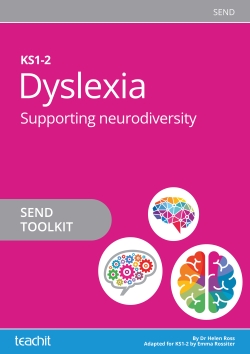Dyslexia toolkit (Primary)

Dyslexia toolkit (Primary) is designed to help class teachers and teaching assistants to support dyslexic pupils in the mainstream classroom at key stage 1 and key stage 2. Whatever your role in supporting children with dyslexia (or dyslexic tendencies), this toolkit will give you understanding, ideas and practical strategies to enable children to access the whole curriculum and make great progress.
Looking to support children in key stages 3 and 4? Try our Dyslexia toolkit for secondary.
Note: Dyslexia toolkit is a digital download, but it is part of our SEND collection and is not included in a Premium subscription.
What’s included?
This 63-page downloadable toolkit includes:
- information about neurodiversity, the strengths of neurodivergent people and some of the challenges they face
- information about dyslexia and how to identify it in the classroom
- a CPD PowerPoint for staff training, parents’ evenings and senior leadership meetings
- advice on avoiding sensory overload
- games to develop learners’ short-term and working memory
- templates for sentence starters, task maps and writing planners to reduce the load on learners’ working memory
- guidance on chunking tasks into manageable steps to help children to process information
- dyslexia strategies for reading
- writing strategies for children with dyslexia
- information about the link between a weak working memory and spelling difficulties, plus dyslexia spelling strategies
- strategies for supporting children with dyslexia in the maths classroom
- top tips on fostering dyslexic strengths such as empathy and problem solving
How does it support dyslexic children?
Dyslexia toolkit (Primary) offers dyslexia-friendly strategies that can be used with the whole class so that neurodivergent learners are not put on the spot. There are also approaches that can be carried out in small groups, and suggestions for how dyslexic children can support their classmates, fostering a supportive learning environment and helping young people to feel empowered. Information and activities are provided to raise awareness of what it feels like to have dyslexia, and ways are suggested of playing to dyslexic learners’ strengths.
The toolkit includes tick lists for learners to articulate their own areas of challenge and learning preferences, and it provides printable resources to help children to plan written tasks (with the support of adults where necessary). It also includes an overview of pros and cons of assistive technology such as electronic readers.
About the writers
Dyslexia toolkit (for secondary schools) was written by Dr Helen Ross, a leading voice on dyslexia within UK education. She is an experienced public speaker, international consultant and researcher, and contributor to a wide range of publications; Helen is also dyslexic.
She supports families, teachers and organisations to better understand the implications of dyslexia, neurodiversity and special educational needs and disabilities (SEND).
In this toolkit, Helen draws on her experiences as a classroom teacher, SENDCo and dyslexia expert to help you to understand what dyslexia is, which aspects of learning can be affected by dyslexia and what you can do to support dyslexic learners.
This toolkit was adapted for a primary audience by Emma Rossiter. Emma is a senior leader, experienced trainer, and highly respected SEN consultant with over 15 years’ experience and dedicated expertise working with children and young adults with special education needs. Emma leads Silverwood School’s SEND Support and Training Service.
What's inside?
- Introduction
- What is neurodiversity?
- What is dyslexia?
- Case studies
- Classroom strategies
- Memory and verbal processing support
- Classroom strategies and activity ideas
- Printable resources
- Reading support
- Classroom strategies and activity ideas
- Printable resources
- Assistive technology
- Writing support
- Printable resources
- Spelling support
- Classroom strategies and activity ideas
- Printable resources
- Maths support
- Classroom strategies and activity ideas
- Printable resources
- Dyslexic strengths
- Classroom strategies
- Further information
- Glossary
- Useful links
- References
For resources to support students with Tourette Syndrome, see the resource collection from our partner Tourettes Action.
Note: Dyslexia toolkit is a digital download, but it is part of our SEND collection and is not included in a Premium subscription.
An extract from the toolkit:
Identifying dyslexia
Dyslexia is a relatively common phenomenon, affecting roughly one in 10 people (NHS, 2018), which means that in any class of 30 children , there are likely to be three students who have dyslexia.
Fairly commonly known signs of dyslexia are that young people experience difficulties in literacy acquisition. Whilst there is a lot of information given in the definition above, sometimes a more practical, tangible understanding of what it looks like in a classroom setting is needed so that we, as educators, know how to support our children. This toolkit is largely focused on addressing the challenges that children with dyslexia have, but we will also talk about the strengths associated with dyslexia; knowing these can empower our children and help us to help them. Here, a broad overview of different elements of dyslexia is given, then, briefly, pathways for identification of dyslexia are discussed – these do differ according to local authority in England and other countries/jurisdictions, so it is not possible within this toolkit to give specific guidance.
